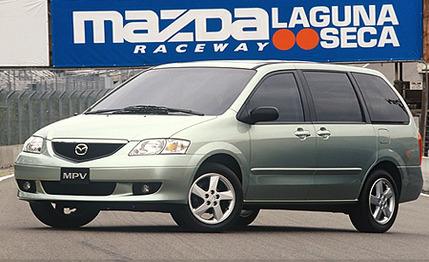 First Drive Review
First Drive Review
"The world doesn't need a me-too minivan from Mazda."
This astute bit of analysis came from Mazda's own Martin Leach, managing director of product planning and design. Who could disagree? Since Chrysler launched the Dodge Caravan and Plymouth Voyager in 1983, the world's cleverest carmakers--and most of the unclever ones, too--have done the minivan thing over and over, producing more variations than Mozart. How could Japan's sixth-largest carmaker, ranked way down in 14th place on the world's list, come up with something new and compelling?
Well, okay, maybe compelling is too much to ask in this category of soccer-mom shuttles. But could a small outfit, this late in the game, create a Mozart quality variation on the now-familiar theme?
After a day's drive in several pilot-production samples, we think the answer is yes. Instead of trying to be all things to all people, the new Mazda MPV (for "multipurpose vehicle") puts its emphasis on lean exterior dimensions and ingenious interior design, resulting in an agile hauler that surprises with its capacity. It looks good, too.
Whereas the mainstream mini vans evolve along bigger-is-better lines--Honda's Odyssey grew 14 inches during its redesign, to 201.2 inches overall, roughly the norm for full-size minis--Mazda shunned bulk. The MPV is 187.0 inches long, just a fraction longer than a short-wheelbase Caravan. At 72.1 inches wide, it's roughly four inches narrower than most of the big guys, too. It's a smaller box--and one that can´t carry four-by-eight plywood lying flat.
But it hauls like a bigger box because the designers found new ways to put room in useful places. The key decision was the location of the temporary-use spare tire; it's amidships, as is the Odyssey's, only Mazda placed it under the floor where it drops to the ground when needed without unloading (you will need access to a screw head under the floor mat just behind the passenger-side front seat). This placement allows the third-row bench to do the same trick it does in the Odyssey: fold into a basin, leaving a perfectly flat floor (left). When the third seat is up, the empty basin serves to enlarge the cargo space to 17.2 cubic feet, nearly four cubic feet more than in the short Caravan.
The MPV is a fresh design built in Hiroshima on an all-new platform. It's a front-engine, front-drive layout with a strut suspension in front, a torsion-beam axle in back, and coil springs all around. A four-wheel-drive version is scheduled for Japan, but Mazda doubts U.S. demand would justify importing it.
Only one powertrain is planned for now, a version of Ford's 2.5-liter Duratec V-6 rated at 170 horse-power (160 hp in California and other LEV states) and coupled to a Ford four-speed automatic. The U.S. drivetrain, Mazda's Leach says, was a currency hedge as much it was a product decision. "The yen exchange was 90 to the dollar [which made Japanese-built cars very expensive here]. We needed to source part of the car in dollars."
Prices start at $20,475 for the least-expensive DX and rise to $26,030 for the top-of-the-line ES with leather seats.
Mazda, in its own quiet way, has been building a reputation for style. The Miata, for example, went from girl-next-door cute to almond-eyed alluring in its 1999 makeover. The Protege's classy looks deny its budget price, and the Millenia is still sexy after all these years (notice we haven't mentioned the 626). Now the detailed sculpting of the basic-box MPV shows just how artistic Mazda's design team is. The five-pointed grille is similar in shape to the Odyssey's but much more forceful, serving as a focus for the hood's bold sculpturing. The hatch door curves just right to keep the rear glass nearly vertical, thereby preserving hauling space yet allowing the rear pillars to sweep forward for a sleek profile. Subtle creases that run the full length of the body sides and around the wheel openings make sharp breaks between light and shadow. The MPV is still a box--that's a minivan given--but it looks crisp and precise.